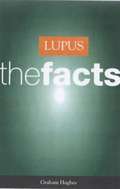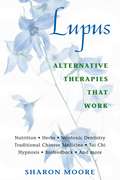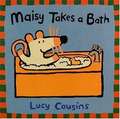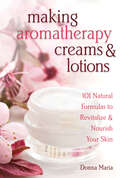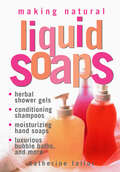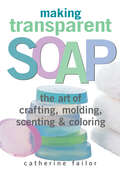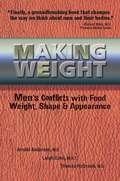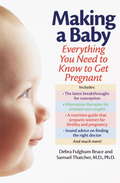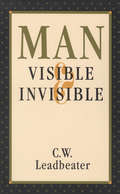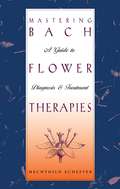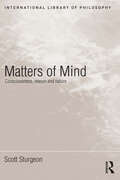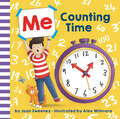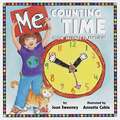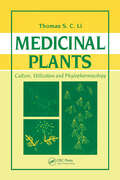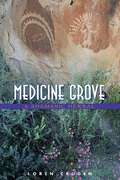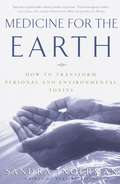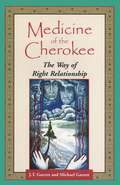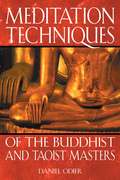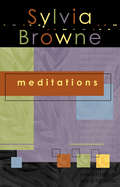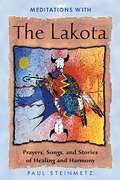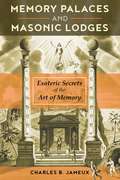- Table View
- List View
Lupus The Facts
by Graham HughesThis easy-to-read book explains Lupus. How does Lupus affect people? What can be done if someone develops lupus?
Lupus: Alternative Therapies That Work
by Sharon MooreA comprehensive guide to noninvasive, nontoxic therapies for lupus--written by a lupus survivor. • The only book to focus on alternative therapies for lupus.• Includes therapeutic approaches drawn from the fields of naturopathic medicine, nutritional medicine, environmental medicine, traditional Chinese medicine, nontoxic dentistry, energy medicine, and psychological healing.• Lupus affects more than four million Americans and does not respond well to conventional treatments. More than four million Americans (90 percent of them women) have been diagnosed with systemic lupus erythematosus, a chronic, debilitating disease of the autoimmune system that manifests itself with extreme fatigue, arthritic pain, rashes, and a host of other symptoms. Add to that the fact that lupus is notoriously difficult to diagnose, and the number of potential sufferers grows. Sharon Moore lived with lupus for several years before doctors finally put a name to it. The only therapies offered to her were pharmaceuticals--toxic drugs that could control or suppress some of her symptoms but couldn't cure her disease. Dissatisfied with this approach, she set about researching alternative treatments for her condition. Nine years later her health is greatly improved, and she has written this book to share the most effective natural healing techniques with other lupus sufferers. Chock full of specific, scientific, well-documented evidence on effective alternative treatments, this book is a godsend for anyone suffering from lupus. Moore provides a comprehensive diagnostic checklist and helps readers identify the possible causes of their illness, from environmental toxins and dental amalgam fillings to compromised liver function and poor nutrition. She offers ways to nurture the mind and spirit when living with chronic disease and shows readers how they can rebuild their lives. Equally important, she writes with the understanding of someone who's been there.
Magic in the Middle Ages
by Richard KieckheferComparison of the different types of Magic used in the Middle Ages and their impact on the people. (ie Necromancy, Astrology, Science)
Maisy Takes a Bath
by Lucy CousinsMaisy, the mouse takes a bath with her best friend. Includes picture descriptions. This file should make an excellent embossed braille copy.
Making Aromatherapy Creams & Lotions: 101 Natural Formulas to Revitalize & Nourish Your Skin
by Donna MariaNourish and revitalize your skin with your own handcrafted creams and lotions. Donna Maria shares her simple five-step method for creating fragrant all-natural body rubs, facial creams, lip balms, moisturizers, and more. Explore how aromatic oils can effectively preserve and protect your skin, and learn how to craft products that target your skin’s specific needs. You’ll be amazed at how your products, which are both inexpensive and free of harsh chemicals, can help promote healthy and vibrant skin. This publication conforms to the EPUB Accessibility specification at WCAG 2.0 Level AA.
Making Natural Liquid Soaps: Herbal Shower Gels, Conditioning Shampoos, Moisturizing Hand Soaps, Luxurious Bubble Baths, and more
by Catherine FailorMake our own liquid soaps and body products right in your kitchen. Catherine Failor shows you how to use her simple double-boiler technique to create luxurious shower gels, revitalizing shampoos, energizing body scrubs, and much more. Step-by-step instructions teach you how to turn basic ingredients like cocoa butter, lanolin, and jojoba into sweet-smelling liquid soaps. You’ll soon be experimenting with your favorite oils and additives as you craft custom-made products that are kind to your nose and gentle on your skin.
Making Plant Medicine
by Richard A. CechMaking Plant Medicine is about making herbal medicine. This is a modern medicine making book and formulary with its roots in original herbalism designed for every medicinal herb gardener to cultivate the full potential of the plant-human relationship. Richo Cech tells very good stories based on his experience as a global wanderer, herbalist and medicine maker. In the context of his lifelong love of gardening, he has produced this long-awaited book that is original, amusing and absolutely useful. Part 1: Medicine Making * drying and processing herbs * making tinctures the easy way * the mathematics of tincturing and solubility factors * basic formulas for fresh and dry tinctures, including dosages * vinegar extracts, glycerites, herbal succi and syrups teas, decoctions, herbal oils, salves and creams poultices, compresses and soaks Part 2: A Gardener's Formulary This section covers well over 100 herbs that are readily cultivated in North America. The listings include: conservation status, parts used, specific formulas, practical uses, dosages, contraindications and an overview of alternate species. Since the beginning, the garden has been a haven of good values, both physical and spiritual. The act of gardening provides a balm for every wound. May your medicine be of the garden, and may it be of benefit to all.
Making Transparent Soap: The Art Of Crafting, Molding, Scenting & Coloring
by Catherine FailorWith basic ingredients and standard kitchen tools you can craft your own transparent soaps that are milder, richer, and creamier than any commercial product. Eschewing complex methods and expensive equipment, Catherine Failor uses a simple, dependable process that makes beautiful transparent soaps every time. Failor’s easy-to-follow photographic instructions are accompanied by proven recipes and plenty of suggestions for colorful and sweet-smelling variations. You’ll soon be creating your own signature soap blends that deliver refreshing scents and are gentle enough for even the most sensitive skin.
Making Weight
by M.D. Arnold Andersen Leigh Cohn M.D. Tom HolbrookThe negative body-image epidemic that affects millions of women is also a hidden problem for millions of men. In spite of a decade-long emphasis on health and fitness - or perhaps because of it - more men are suffering from a variety of eating disorders and self-abusive behaviors. Using vignettes from their patients, the authors present a new program to help men overcome these problems. They offer ways to enhance self-image, facts about why diets fail, information about the dangers of using steroids, and a section for women who want to help the men in their life.
Making a Baby
by Debra Fulghum Bruce Samuel ThatcherYou may have waited a long time. You may have tried and tried. Now your chances of having a baby are better than ever! There have been remarkable advances in fertility technology and choices in the last few years, with pregnancy success rates skyrocketing. Now Making a Baby provides the information you need to become your most fertile--and increase your chances for having the baby you've always wanted. Up-to-date, comprehensive, written with compassion and clarity, this book reveals how to protect, increase, and extend your fertility, with essential information on: - The optimal frequency, timing, and sexual positions for getting pregnant - Surprising new findings on which foods and exercise programs boost fertility--and which ones actually decrease your chances - Advances in baby-boosting medications--and a complete assessment of risks, costs, and alternatives - Breakthrough medical techniques that help achieve pregnancy without the risk of multiples - Avoiding the common--and often hidden--threats to fertility at work, at home, and in public places - Choosing the A. R. T. (assisted reproductive technology) that's right for you - Special issues for midlife mothers - What every man should know about his long-term reproductive health - How to minimize emotional stress and keep your relationship strong - How to work with your HMO to get the right treatments--at the right cost This detailed, insightful, and meticulously researched book will help guide you to a wonderful new beginning as a parent!
Man, Visible and Invisible
by Charles Webster LeadbeaterThis esoteric classic examines the invisible bodies of humans, showing how the colors of the aura change with different emotional states.
Man, Visible and Invisible
by C W LeadbeaterThis esoteric classic examines the invisible bodies of humans, showing how the colors of the aura change with different emotional states.
Mastering Bach Flower Therapies: A Guide to Diagnosis and Treatment
by Mechthild SchefferIn Mastering Bach Flower Therapies: A Guide to Diagnosis and Treatment, Mechthild Scheffer presents a comprehensive guide to incorporating Bach flowers into your life. The first practitioner to recognize the psychological underpinnings of the Bach flower remedies, Scheffer demonstrates that emotional and physical well-being are inextricably linked and shows how the flower therapies can be a powerful tool-not only for healing individual symptoms, but for putting the course of one's life back on track. With a thorough diagnostic questionnaire and color spectrographs of the most popular flowers, Mastering Bach Flower Therapies gives you all the expertise you need to put the healing therapies to work. Scheffer's groundbreaking best-seller Bach Flower Therapy: Theory and Practice revolutionized the science of Bach flower remedies, detailing the healing properties of each individual flower. Rather than using a dry, theoretical approach to treatment, Scheffer gives first-hand accounts of patients cured by the flowers and provides expert commentary on the course of their diagnosis, treatment, and recovery.
Matters of Mind: Consciousness, Reason and Nature (International Library of Philosophy)
by Scott SturgeonMatters of Mind examines the mind-body problem. It offers a chapter by chapter analysis of debates surrounding the problem, including visual experience, consciousness and the problem of Zombies and Ghosts. It will prove invaluable for those interested in epistemology, philosophy of mind and cognitive science.
McGraw Hill Health: Grade 2
by Mcgraw HillMcGraw-Hill Health was created to help you be as healthy as you can be. The McGraw-Hill Health Pyramid shows what you need to reach the goal of good health.
Me Counting Time
by Joan SweeneyHow long is a minute? What is a decade? How many decades are in a century?Now with new illustrations by Alex Willmore, Me Counting Time is a playful introduction to the concept of time. When a young boy prepares for his seventh birthday and counts how many years old he is, he begins on an exploration of the many units of time that are a part of everyday life. Fun to read, easy to understand, and brimming with colorful illustrations, this title joins the other repackages in Joan Sweeney's popular Me...series--Me on the Map, Me and My Place in Space, Me and My Amazing Body, Me and My Family Tree, Me and the Measure of Things, and Me and My Senses.
Me Counting Time: From Seconds to Centuries
by Joan SweeneyHow long is a second? Can you count a minute? What is a decade? How many years are in a century?Me Counting Time can show you! From a second to a minute to an hour to a day — and all the way to a millennium — this playful introduction to time helps children understand the many measurements of time and how they’re used in everyday life. Easy to read and easy to understand, Me Counting Time makes learning a fun time for every child.
Medicinal Plants: Culture, Utilization and Phytopharmacology
by Thomas S. LiMedicinal Plants: Culture, Utilization and Phytopharmacology covers over 400 species. Each chapter gathers valuable information from a wide variety of sources, and supplies it to the user in convenient table format, arranged alphabetically by scientific name, followed by the common name. Data topics include: major constituents (active ingredients)
Medicine Grove: A Shamanic Herbal
by Loren CrudenMedicine Grove is a comprehensive herbal, with listings for every common herb and many wild plants of North America. It includes descriptions of the part of the plant used, notes on preparation, lists of symptoms alleviated by the herb, and common effects. But Medicine Grove goes further, with chapters on gathering and growing wild herbs, using herbs in shamanic ceremonies or as plant allies in the wilderness, and birth, death, and dreaming herbs. Cruden combines her own first-hand experiences with a profound knowledge of indigenous traditions, enabling the reader to bring herbal lore into his or her own practice. She explains which herbs are best for seasonal ceremonies, smudging, and making offerings, and tells how to purify a sacred space. She covers topics such as vision quests, consciousness-altering, and the special connections between certain herbs and totem animals.Medicine Grove brings the concept of an herbal into sacred territory, offering guidelines for incorporating herbs into one's spiritual life, based on the author's lifetime of work with Native American practices.
Medicine for the Earth: How to Transform Personal and Environmental Toxins
by Sandra IngermanFrom cross-cultural legends recounting shamanic cures to the biblical accounts of the parting of the Red Sea and Jesus multiplying the loaves and fishes, many spiritual traditions are rich in stories about seemingly inexplicable transformations of the natural world. The ancient healing art of transmutation, in which toxic substances are transformed into "safe" substances, is mentioned in all the world's great spiritual traditions, including Hinduism and Taoism. And while many have tapped this body of work to heal the self, it has yet to be used to heal our environment. For twenty years, Sandra Ingerman has studied alternative ways to reverse environmental pollution. In this book, Ingerman takes us on a remarkable journey through the history of transmutation, teaching us how we can use this forgotten technique to change ourselves and our environment. She provides us with creative visualizations, ceremonies, rituals, and chants derived from ancient healing practices that produce miraculous, scientifically proven results. In one dramatic illustration of what can be accomplished when consciousness and awareness fuel our actions, Ingerman describes her own success in transforming the nature of chemically polluted water.
Medicine of the Cherokee: The Way of Right Relationship
by Michael Tlanusta Garrett J. T. GarrettDiscover the holistic experience of human life from the elder teachers of Cherokee Medicine. With stories of the Four Directions and the Universal Circle, these once-secret teachings offer us wisdom on circle gatherings, natural herbs and healing, and ways to reduce stress in our daily lives.
Meditation Techniques of the Buddhist and Taoist Masters
by Daniel OdierA guide to the mental disciplines and visualizations that Masters have used for ages in their quest for illumination. * An insider's view of specific meditation techniques and the steps necessary for a wide variety of * Buddhist and Taoist meditation practices. * By the author of Tantric Quest (15,000 sold) and Desire: The Tantric Path to Awakening. The esoteric practices followed in the quest for divinity generally remain a secret to the world--kept cloistered away for only the most ascetic practitioners. Now Daniel Odier, having immersed himself in the life and spiritual practices of Buddhist and Taoist monasteries throughout India, Nepal, Sri Lanka, Thailand, and Japan, reveals actual teachings passed on by the sages who are living expressions of their tradition. Looking beyond doctrine, dogma, and philosophical treatises that ignore direct experiences of the practice, Odier provides a direct path to the heart of the religious experience that can be discovered through meditation. Beginning with the simple and fundamental steps necessary to prepare for meditation, Odier guides the reader through the specifics of the mental disciplines and visualizations that Buddhist and Taoist masters have used for ages in their quest for illumination. To devote oneself to meditation, in the sense understood by Buddhists and Taoists, is to realize the understanding of how every fiber of our being converges with all creation. Meditation Techniques of the Buddhist and Taoist Masters is a valuable guide to all who are in search of that realization.
Meditations
by Sylvia BrowneIn this beautifully illustrated book, renowned psychic and bestselling author Sylvia Browne brings you a heartfelt meditation for each week of the year. Based on the tenets of her church, the Society of Novus Spiritus, these meditations will serve to inspire you, help you relax, and allow you to see the divine nature that exists within you at all times.
Meditations with the Lakota: Prayers, Songs, and Stories of Healing and Harmony
by Paul Steinmetz• Native American meditations that help the reader find spirit in everyday life. • Intimate meditations offer insight into the symbology of the Lakota religious experience. • Lakota elders present the ancient prayers that weave together psyche and spirit. • New Edition of Meditations with Native Americans. The Lakota, people of the sacred buttes of the Black Hills, hold a rich tradition that connects the world of visible creation to the world of spirit. A century after the battle at Wounded Knee, Lakota elders are beginning to speak their belief that this spirituality is indigenous to every man and woman. By inviting all nations to recognize their interdependence with one another and with the earth, Native Americans can help modern man and woman find a personal relationship with nature and a willingness to view creation as sacred. Many feel that this spirituality is not a luxury but a necessity. From impressions and teachings gathered over decades of living with the Oglala Sioux and participating in their ceremonies, author Paul Steinmetz has compiled a book of provocative meditations centered on creation spirituality. Lakota elders join the author in evoking the essence of the sweat lodge ceremony, the vision quest, yuwipi meetings, and the teachings of Buffalo Calf Woman and the sacred pipe, offering the reader a focus for prayerful intention in finding spirit in everyday life. This insider's view reveals the Lakotas' profound interconnectedness with all matter, a weaving of psyche and spirit that is the call to consciousness so crucial at this time.
Memory Palaces and Masonic Lodges: Esoteric Secrets of the Art of Memory
by Charles B. JameuxReveals how the art of memory is the origin of the Masonic method • Explains the classical techniques of the art of memory, how they were reworked by hermetic thinkers during the Renaissance, and how they contributed to the transformation of operative Freemasonry into speculative Freemasonry • Traces the creation of speculative Freemasonry to 1637, one hundred years earlier than previously thought • Explores how the “memory palaces” created with the art of memory enabled access to universal knowledge as well as represented the Masonic temple in its imaginary state In Antiquity, the art of memory was a mnemonic device that allowed an orator, such as Cicero, to recall all the points he wished to make by associating each of them with an image or architectural element in the site he was speaking. When this art was rediscovered in the Renaissance, hermetic thinkers like Giordano Bruno reworked it into a method that allowed them to acquire knowledge with the creation of “memory palaces.” The elements of these memory palaces were not intended to trigger the memory but would actually transform into talismanic objects with knowledge entirely new to the seeker. In this book, Charles B. Jameux shows that this hermetic reworking of the classical art of memory was no mystery to operative Masons, who grafted it onto their own rituals, catalyzing the transformation of operative Masonry into speculative Masonry. He shows how the hieroglyphic writing used during the Renaissance in the art of memory provided the groundwork for one of the most esoteric elements of masonic practice: the grasp of the realm of image by the letter, where symbols were “buried” within words. Using archival evidence from 17th-century Scotland and earlier, combined with the research of modern scholars such as Frances Yates and David Stevenson, Jameux argues that the creation of speculative Freemasonry can be traced back 100 years earlier than conventional history records--to 1637, when the first recorded use of the Mason’s Word appeared and with it, the first known appearance of the symbolic Temple of Solomon. He follows Giordano Bruno’s visit to the British Isles in the late 16th century and the subsequent activities of the men he met there, showing that Masonic symbolism owes much of its current form to early memory palaces, which represented the Masonic lodge and temple in their fully imaginary states. Revealing the pivotal role of the memory palace and hermetic traditions in early Masonic symbolism, Jameux sheds new light on the Masonic questions asked of each initiate and the spiritual importance of the Temple of Jerusalem to Freemasonry.
